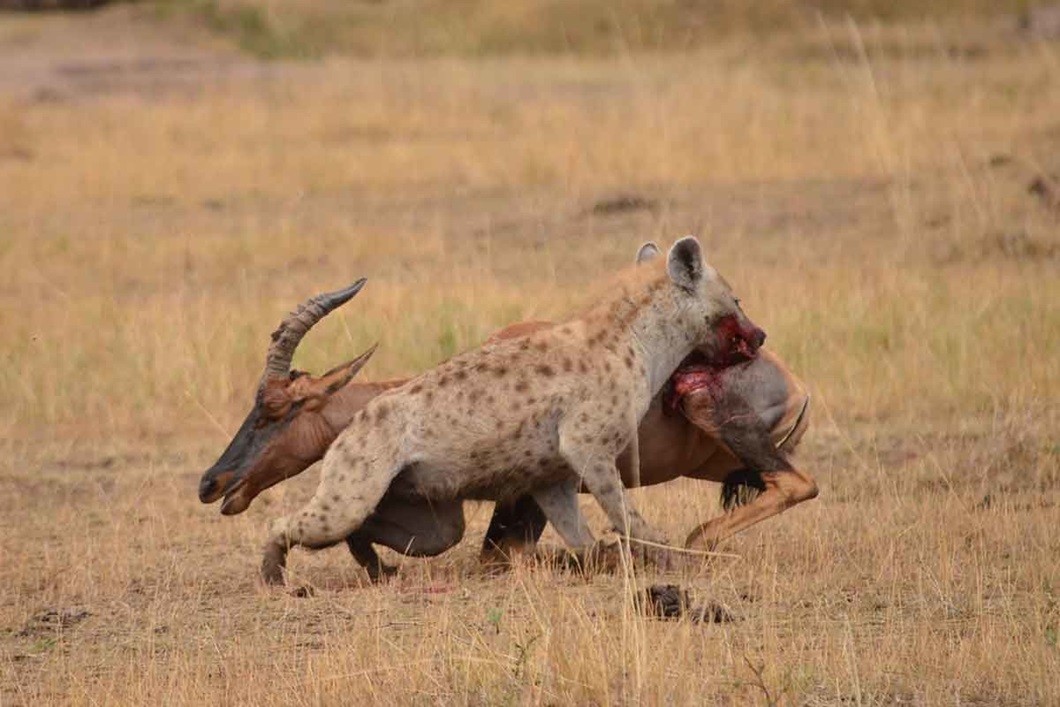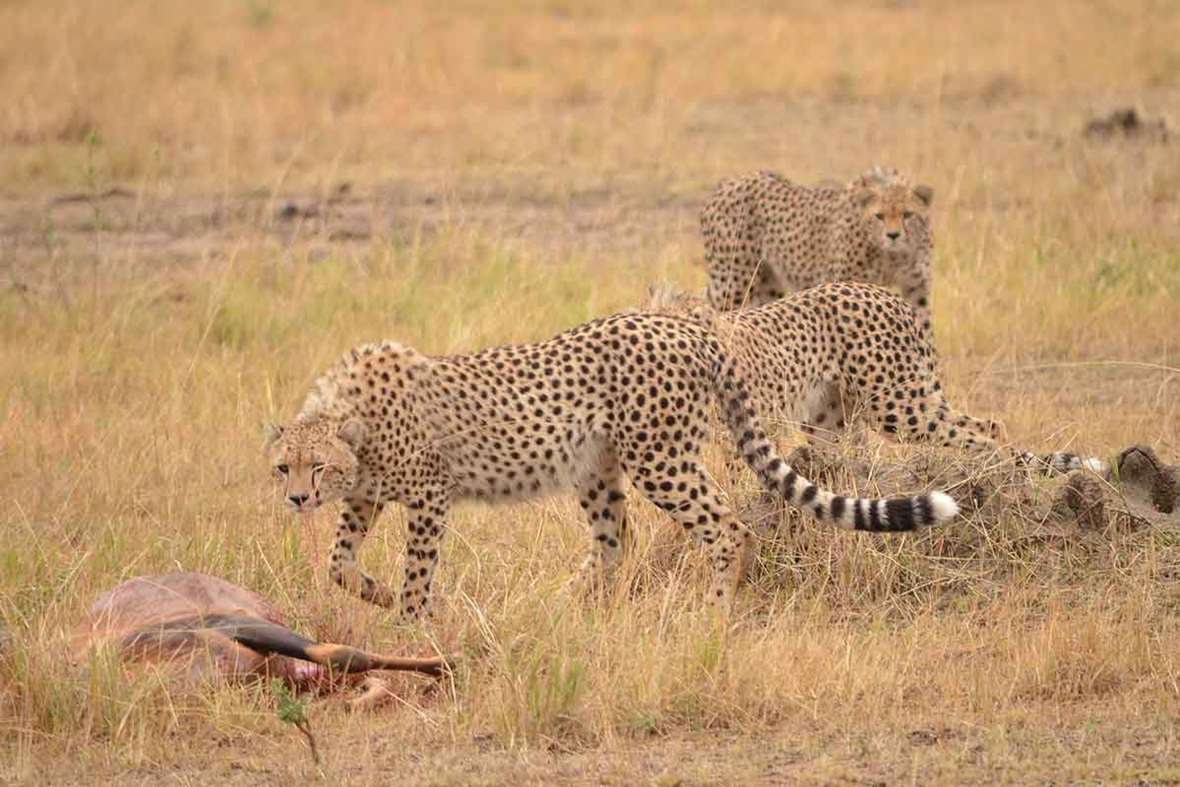June 09 2016
Late last year, safari guide Onesmus Irungu photographed a rather unusual scene on a morning out in Kenya’s Maasai Mara National Reserve: a spotted hyena getting chased off its kill by a mother cheetah and her three cubs.
The sighting might be the first time that such behaviour has ever been caught on camera – and when it comes to upending stubborn misconceptions about Africa's carnivores, Irungu's three snapshots do a pretty good job.
For a start, the hunting prowess of the hyena is on show. Often unfairly branded as nature's cackling thieves and scavengers (thanks, Lion King), hyenas are actually very capable predators – in fact, research suggests they kill up to 95% of the food they eat. And this particular hunter, likely a young male, had managed to take down a topi, one of Africa's speediest antelopes.
Unfortunately, the hyena barely had time to sample its spoils before trouble arrived. A female cheetah approached the carcass with her three 15-month-old cubs in tow, and the youngsters initiated the chase. Outnumbered, the lone hyena had no choice but to abandon its breakfast, and the feline family settled in for an undisturbed two-hour feast.
Seeing the poster animal for the high-speed hunt turn to scavenging is surprising, and the behaviour is indeed highly unusual. "Cheetahs have been seen stealing kills from other cheetahs, but to my knowledge there are no published reports of cheetahs actively stealing from any other predators," says Femke Broekhuis, who, along with Irungu, described the event in a recent paper.
When it comes to carcass theft, it's usually the cheetahs who lose out. Their smaller size and mostly solitary habits make them vulnerable, and in some parts of Africa, more than 12% of their kills are commandeered by larger rival carnivores. Such thieving tactics have earned lions and spotted hyenas a share of the blame for the serious decline in cheetah numbers, yet sightings like Irungu's add to other evidence that these lithe spotted cats can cope with losing the occasional meal – and are flexible enough to adapt their behaviour in order to survive. Scavenging, it turns out, might be one way they get by.
Appropriating an unguarded carcass is one thing, but stealing it from a larger predator is a risky move, and it's possible this cheetah mother took her chances because she had three extra mouths to feed. For Broekhuis, who is the director of the Mara Cheetah Project in Nairobi, Kenya, the behaviour helps us to see the predators in a different light. "Cheetahs are always portrayed as being very vulnerable, but the sighting of cheetah taking a kill from a hyaena not only shows that they will scavenge, but also that they can confront other predators to obtain resources," she says.
It also helps researchers tease out the real threats facing these cats, most of which can be linked to human activity – from habitat loss and disappearing prey to the illegal pet trade. "Both lions and spotted hyaenas are known to kill cheetahs and to steal their kills, but these three species have always coexisted and these interactions are all part of a natural system – unless there is a human cause for increased interactions," adds Broekhuis.
Top header image: Erlend Aasland, Flickr
source
The sighting might be the first time that such behaviour has ever been caught on camera – and when it comes to upending stubborn misconceptions about Africa's carnivores, Irungu's three snapshots do a pretty good job.
For a start, the hunting prowess of the hyena is on show. Often unfairly branded as nature's cackling thieves and scavengers (thanks, Lion King), hyenas are actually very capable predators – in fact, research suggests they kill up to 95% of the food they eat. And this particular hunter, likely a young male, had managed to take down a topi, one of Africa's speediest antelopes.
Unfortunately, the hyena barely had time to sample its spoils before trouble arrived. A female cheetah approached the carcass with her three 15-month-old cubs in tow, and the youngsters initiated the chase. Outnumbered, the lone hyena had no choice but to abandon its breakfast, and the feline family settled in for an undisturbed two-hour feast.
Seeing the poster animal for the high-speed hunt turn to scavenging is surprising, and the behaviour is indeed highly unusual. "Cheetahs have been seen stealing kills from other cheetahs, but to my knowledge there are no published reports of cheetahs actively stealing from any other predators," says Femke Broekhuis, who, along with Irungu, described the event in a recent paper.
When it comes to carcass theft, it's usually the cheetahs who lose out. Their smaller size and mostly solitary habits make them vulnerable, and in some parts of Africa, more than 12% of their kills are commandeered by larger rival carnivores. Such thieving tactics have earned lions and spotted hyenas a share of the blame for the serious decline in cheetah numbers, yet sightings like Irungu's add to other evidence that these lithe spotted cats can cope with losing the occasional meal – and are flexible enough to adapt their behaviour in order to survive. Scavenging, it turns out, might be one way they get by.
Appropriating an unguarded carcass is one thing, but stealing it from a larger predator is a risky move, and it's possible this cheetah mother took her chances because she had three extra mouths to feed. For Broekhuis, who is the director of the Mara Cheetah Project in Nairobi, Kenya, the behaviour helps us to see the predators in a different light. "Cheetahs are always portrayed as being very vulnerable, but the sighting of cheetah taking a kill from a hyaena not only shows that they will scavenge, but also that they can confront other predators to obtain resources," she says.
It also helps researchers tease out the real threats facing these cats, most of which can be linked to human activity – from habitat loss and disappearing prey to the illegal pet trade. "Both lions and spotted hyaenas are known to kill cheetahs and to steal their kills, but these three species have always coexisted and these interactions are all part of a natural system – unless there is a human cause for increased interactions," adds Broekhuis.
This might be the first time that a carcass-stealing cheetah has been caught on camera, but the team behind the Mara Cheetah Project hopes future observations will tell them whether it was more than just a fluke. The long-term project sees researchers tracking cats out in the field each day and recording their behaviour.
"We currently have approximately 75 different cheetahs in our database, which allows us to follow individuals over time, so it is possible that we might observe this behaviour again at some point," Broekhuis says.
__Top header image: Erlend Aasland, Flickr
source



No comments:
Post a Comment